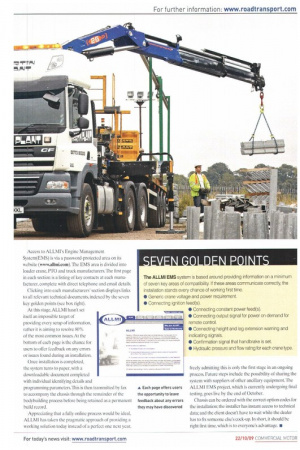Get it right first time
Page 44

Page 45

If you've noticed an error in this article please click here to report it so we can fix it.
You know what you want, you order the product, it gets built... and it doesn't work. How many operators have gone through this? ALLMI has developed a system to combat this problem.
Words: Colin Barnett
So you want a new lorry with a crane fitted? No problem. Order the truck, have the PTO fitted, have the crane fitted, have the body fitted, then send it back to the dealer to have the PD!.
Unfortunately, in the past, these steps, where no party talks to any others, means there's a chance that something won't work properly when the end-user tries to put their shiny new truck 10 work. A conservative estimate puts the number of problem installations at around 10% to 15%.
The key areas leading to an unsuccessful installation revolve around communication problems in the chain, from crane installer to the dealer carrying out the final PDI, including lack of easy access to relevant information, and the absence of an audit trail. Specific technical problems include incorrect programming and wiring changes made by other parties further down the bodybuilding chain. Of course, the current state of the truck market isn't helping, with a higher proportion of built vehicles being sold from stock and having to be modified, and general pressures on cost and delivery times.
Two years ago, a meeting of the Association of Lorry Loader Manufacturers and Importers (ALLMI) convened to try to resolve the problem, and a working group of interested parties was formed to find a solution. In the long term, European rule-makers are working on a common CAN-bus interface to overcome the fact that every chassis and crane-maker has its own system. This should create a manufacturer-specific, crane-generic interface plug similar to those used for refuse collection vehicles, but the results are around two to five years away.
As an interim solution, ALLMI has launched a combined electronic and paper-based support system to allow all interested parties to have access to each other's technical data, and to provide a recording system to follow a crane installation through its build and subsequent in-service life. Participants in the working group included representatives of chassis manufacturers, crane manufacturers and installers and PTO suppliers, with all the major chassis-makers now providing data. Access to ALLMI's Engine Management System(EMS) is via a password-protected area on its website (www.allmi.com). The EMS area is divided into loader crane, PTO and truck manufacturers. The first page in each section is a listing of key contacts at each manufacturer, complete with direct telephone and email details.
Clicking into each manufacturers' section displays links to all relevant technical documents, indexed by the seven key golden points (see box right).
At this stage. ALLMI hasn't set itself an impossible target of providing every scrap of information, rather it is aiming to resolve 80% of the most common issues. At the bottom of each page is the chance for users to offer feedback on any errors or issues found during an installation.
Once installation is completed, the system turns to paper, with a downloadable document completed with individual identifying details and programming parameters.This is then transmitted by fax to accompany the chassis through the remainder of the bodybuilding process before being retained as a permanent build record.
Appreciating that a fully online process would be ideal, ALLMI has taken the pragmatic approach of providing a working solution today instead of a perfect one next year, freely admitting this is only the first stage in an ongoing process. Future steps include the possibility of sharing the system with suppliers of other ancillary equipment. The ALLMI EMS project, which is currently undergoing final testing, goes live by the end of October.
Chassis can be ordered with the correct option codes for the installation; the installer has instant access to technical data; and the client doesn't have to wait while the dealer has to fix someone else's cock-up. In short, it should be right first time, which is to everyone's advantage.
















































































































































